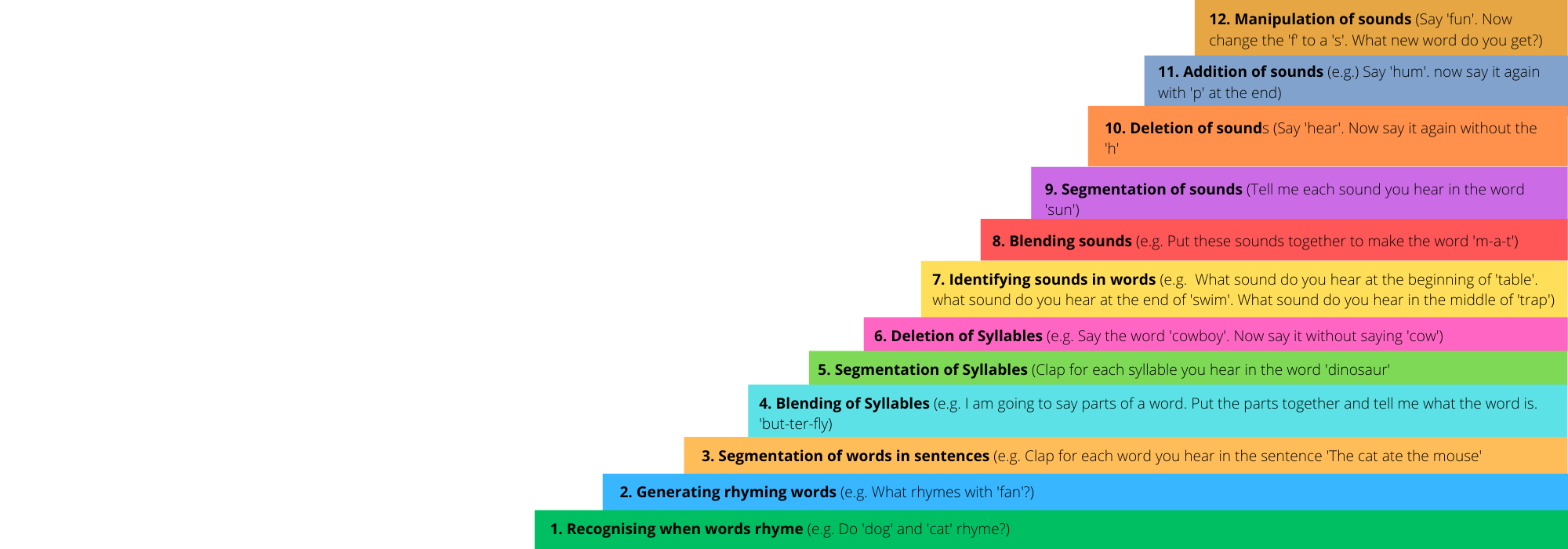What is Phonological Awareness?
Phonological awareness refers to the ability to recognize and manipulate the sounds or phonemes in spoken language. Having good phonological awareness skills means that a child can ‘play’ with sounds and words. For example, a teacher or speech therapist might ask a child to break the word ‘dog’ into its individual sounds: d-o-g.
Phonological awareness includes the following skills:

Why is it important?
Phonological awareness is a crucial component of early literacy development.
It is considered an important precursor to reading and writing skills because it helps children develop an understanding of how sounds and letters are related. Children who have strong phonological awareness skills are more likely to learn to read and write quickly and accurately, and to become proficient readers and writers in the long term.
Phonological awareness helps children to understand the sound structure of words and how to decode them. When children can recognize the sounds in words, they can sound out unfamiliar words and read them accurately. Phonological awareness also helps children to spell words correctly, because it allows them to understand the sound structure of words and how letters correspond to those sounds.
Phonological awareness is also important for the development of vocabulary and comprehension skills. When children have a strong foundation in phonological awareness, they are better able to understand the meaning of words and make connections between words that share common sounds.
Phonological awareness warning signs
There are several signs you can look out for if you suspect that your child may have phonological awareness difficulties. Here are some common signs that may indicate challenges in this area:
- Difficulty with rhyming: Your child may struggle to identify and produce words that rhyme, such as cat, rat, and mat.
- Trouble segmenting words: Your child may have difficulty breaking words into individual sounds or syllables. For example, they may struggle to separate the sounds in the word “cat” (c-a-t).
- Challenges with blending sounds: Your child may find it hard to combine individual sounds to form words. For instance, they might have trouble blending the sounds /d/-/o/-/g/ to make the word “dog.”
- Difficulty identifying beginning or ending sounds: Your child may struggle to isolate the initial or final sounds in words. For example, they might have trouble identifying the starting sound in the word “sun” or the ending sound in the word “cat.”
- Problems with manipulating sounds: Your child may find it challenging to substitute, add, or delete sounds in words. They might struggle to change the sound /r/ in “rat” to /b/ to make the word “bat.”
- Slow progress in learning letter-sound correspondence: Your child may have difficulty connecting letters with their corresponding sounds. They might struggle to recognize the sounds associated with specific letters or letter combinations.
- Struggles with spelling: Phonological awareness difficulties can often lead to challenges in spelling, as your child may have trouble identifying and manipulating the sounds in words.
It’s important to note that these signs alone do not provide a definitive diagnosis of phonological awareness difficulties. If you notice several of these signs or have concerns about your child’s language development, it’s recommended to consult with a qualified speech-language therapist who can assess your child’s skills and provide appropriate guidance and support.
How can I help develop my child’s Phonological Awareness skills?
There are many fun and engaging activities that parents can do with their children to help develop phonological awareness skills. Here are some ideas:
- Rhyming games: Play games that involve finding words that rhyme. You can start by saying a word, such as “cat”, and ask your child to come up with a word that rhymes, such as “bat”. You can also play rhyming bingo, where you call out a word and your child marks off a picture of a word that rhymes with it.
- Sound matching: Play games that involve matching words with the same beginning or ending sounds. You can start by saying a word, such as “cat”, and ask your child to come up with another word that starts with the same sound, such as “cup”. You can also play sound scavenger hunt, where you go around the house or outside and ask your child to find objects that start with a certain sound.
- Syllable counting: Play games that involve counting the number of syllables in words. You can start by saying a word, such as “butterfly”, and ask your child to clap or tap the number of syllables in the word. You can also play syllable sorting, where you give your child a few objects and ask them to sort them into piles based on how many syllables they have.
- Sound segmenting and blending: Play games that involve segmenting words into their individual sounds and blending sounds together to form words. You can start by saying a word, such as “cat”, and asking your child to say each sound in the word, such as “c-a-t”. You can also play sound hopscotch, where you draw a hopscotch board on the ground and your child jumps on each square while saying a sound, then jumps on the last square while saying the whole word.
Phonological and Phonemic awareness is the foundation upon which all other layers of literacy are built and, unless it is solid, the other layers will most definitely suffer, and the child will struggle to read. It is however important that parents and educators continue to motivate children to view reading as a positive experience despite their challenges. Kate Dicamillo expressed this beautifully when she wrote “Reading should not be presented to children as a chore, or a duty. It should be offered as a gift”.
Written by Angela Pouroullis (Speech-Language Therapist at Glenoaks School)
- When to Push My Child and When to Step Back - March 18, 2024
- Benefits of Including STEM into the Classroom - March 5, 2024
- The Role of Parents in the Education of Special Needs Children and Fostering a Collaborative Approach - February 21, 2024





